| # Memory Benchmarks |
| |
| This document describes benchmarks available to track Chrome's and |
| WebView's memory usage, where they live, what they measure, how to run them, |
| and on how to diagnose regressions. |
| |
| [TOC] |
| |
| ## Glossary |
| |
| * **User story:** a set of actions to perform on a browser or device (e.g. |
| open google homepage, type "foo", click search, scroll down, visit first |
| result, etc.). |
| * **Metric:** a data aggregation process that takes a Chrome trace as input |
| (produced by a [Telemetry][] run) and produces a set of summary numbers as |
| output (e.g. total GPU memory used). |
| * **Benchmark:** a combination of (one or more) user stories and (one or |
| more) metrics. |
| |
| [Telemetry]: https://github.com/catapult-project/catapult/blob/master/telemetry/README.md |
| |
| ## System Health |
| |
| *System health* is an effort to unify top-level benchmarks (as opposite to |
| micro-benchmarks and regression tests) that are suitable to capture |
| representative user stories. |
| |
| ### Benchmarks |
| |
| System health memory benchmarks are: |
| |
| * [system_health.memory_mobile][system_health] - |
| user stories running on Android devices. |
| * [system_health.memory_desktop][system_health] - |
| user stories running on desktop platforms. |
| |
| These benchmarks are run continuously on the [chrome.perf][] waterfall, |
| collecting and reporting results on the |
| [Chrome Performance Dashboard][chromeperf]. |
| |
| [system_health]: https://chromium.googlesource.com/chromium/src/+/main/tools/perf/page_sets/system_health/ |
| [chrome.perf]: https://ci.chromium.org/p/chrome/g/chrome.perf/console |
| [chromeperf]: https://chromeperf.appspot.com/report |
| |
| ### User stories |
| |
| System health user stories are classified by the kind of interactions they |
| perform with the browser: |
| |
| * `browse` stories navigate to a URL and interact with the page; e.g. |
| scroll, click on elements, navigate to subpages, navigate back. |
| * `load` stories just navigate to a URL and wait for the page to |
| load. |
| * `background` stories navigate to a URL, possibly interact with the |
| page, and then bring another app to the foreground (thus pushing the |
| browser to the background). |
| * `long_running` stories interact with a page for a longer period |
| of time (~5 mins). |
| * `multitab` loads different web sites in several tabs, then cycles through |
| them. |
| * `play` loads a web site and plays some media (e.g. a song). |
| |
| The full name of a story has the form `{interaction}:{category}:{site}[:{year}]` |
| where: |
| |
| * `interaction` is one the labels given above; |
| * `category` is used to group together sites with a similar purpose, |
| e.g. `news`, `social`, `tools`; |
| * `site` is a short name identifying the website in which the story mostly |
| takes place, e.g. `cnn`, `facebook`, `gmail`. |
| * `year` indicates the year in which the web page recording for the story |
| was most recently updated. |
| |
| For example `browse:news:cnn:2018` and `background:social:facebook` are two |
| system health user stories. The list of all current stories can be found at |
| [bit.ly/csh-stories](http://bit.ly/csh-stories). |
| |
| Today, for most stories, a garbage collection is forced at the end of the |
| story and a memory dump is then triggered. Metrics report the values |
| obtained from this single measurement. |
| |
| ## Continuous monitoring |
| |
| 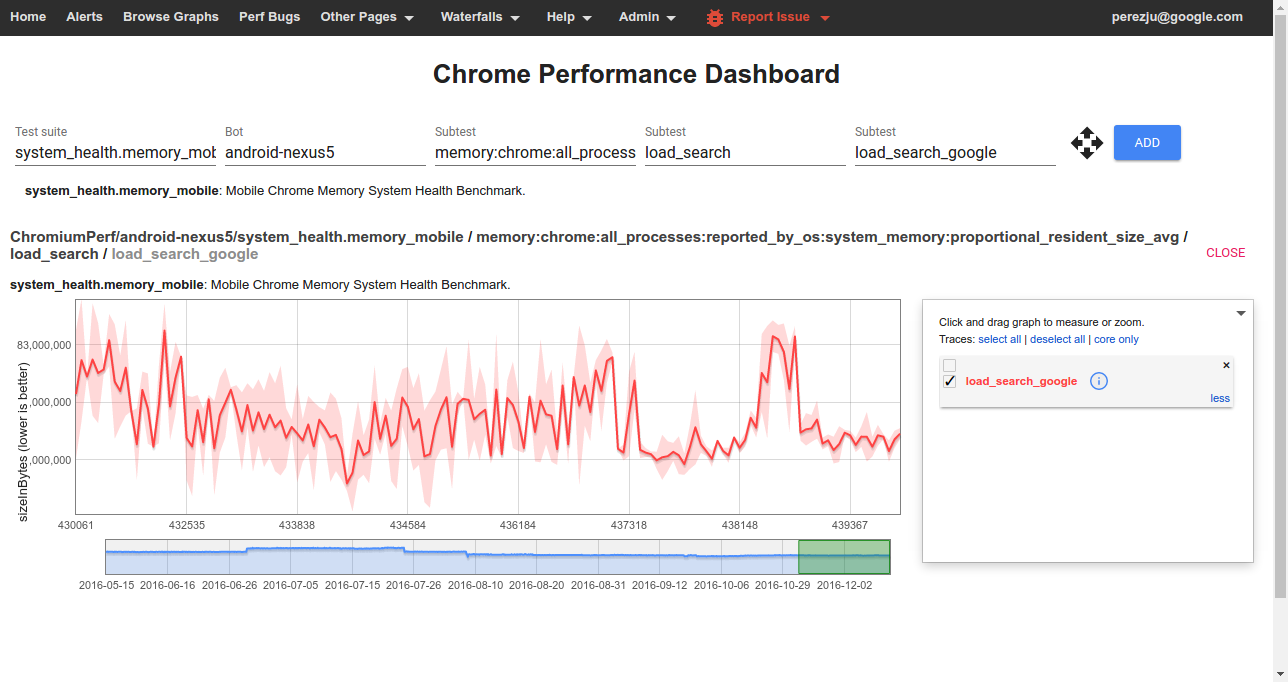 |
| |
| To view data from one of the benchmarks on the |
| [Chrome Performance Dashboard][chromeperf] you should select: |
| |
| * **Test suite:** The name of a *[benchmark](#Benchmarks)*. |
| * **Bot:** The name of a *platform or device configuration*. Sign in to also |
| see internal bots. |
| * **Subtest (1):** The name of a *[metric](#Understanding-memory-metrics)*. |
| * **Subtest (2):** The name of a *story group*; these have the form |
| `{interaction}_{category}` for system health stories. |
| * **Subtest (3):** The name of a *[user story](#User-stories)* |
| (with `:` replaced by `_`). |
| |
| Clicking on any point of the graph will give you the commit range, links to the |
| builder that ran the benchmark, and a trace file collected during the story |
| run. See below for details on how to interpret these traces when |
| [debugging memory related issues](#debugging-memory-regressions). |
| |
| Many of the high level memory measurements are automatically tracked and the |
| Performance Dashboard will generate alerts when a memory regression is detected. |
| These are triaged by [perf sheriffs][] who create bugs and start bisect jobs |
| to find the root cause of regressions. |
| |
| [perf sheriffs]: /docs/speed/perf_regression_sheriffing.md |
| |
| 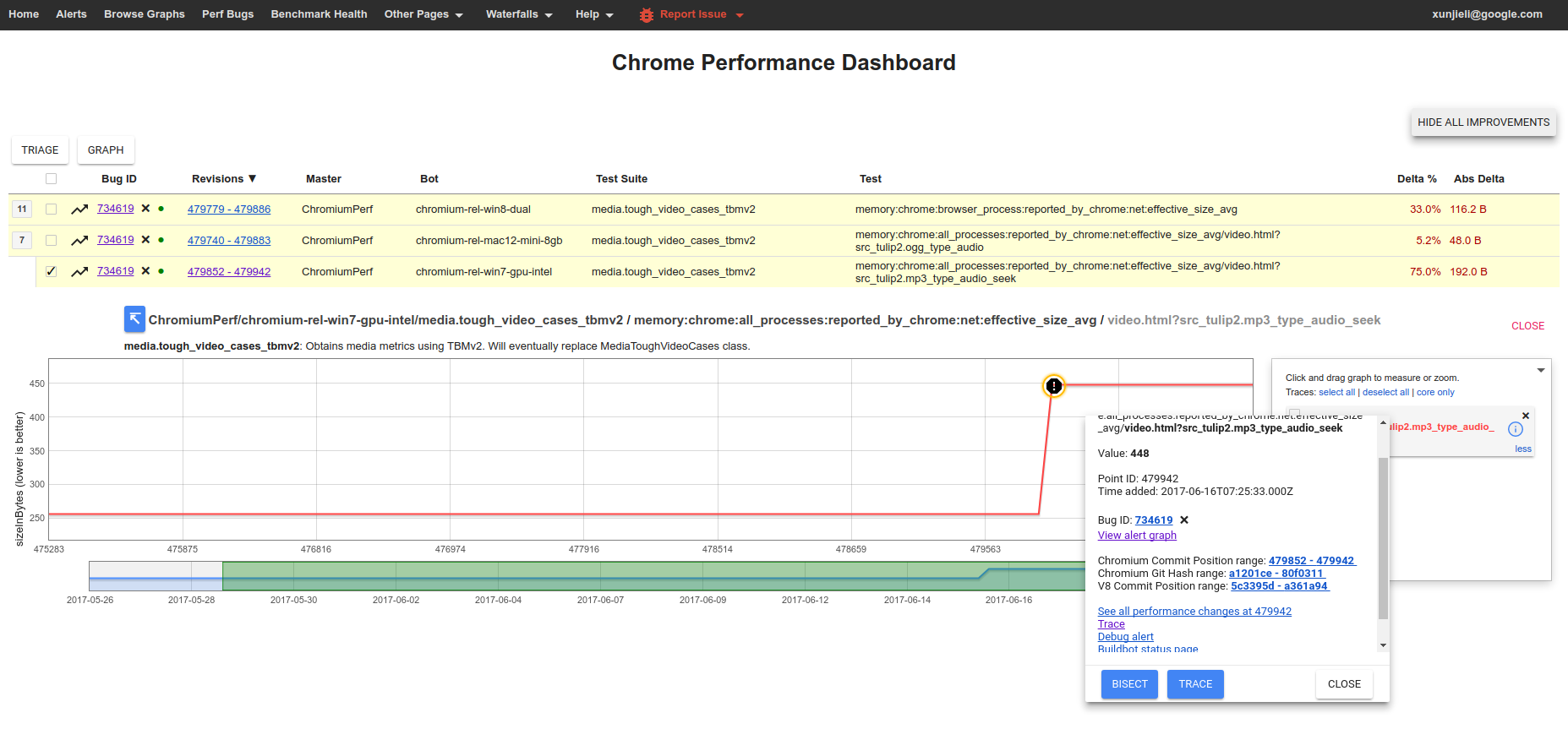 |
| |
| ## Debugging memory regressions |
| |
| If you are investigating a memory regression, chances are, a [pinpoint][] |
| job identified one of your CLs as a possible culprit. |
| |
| 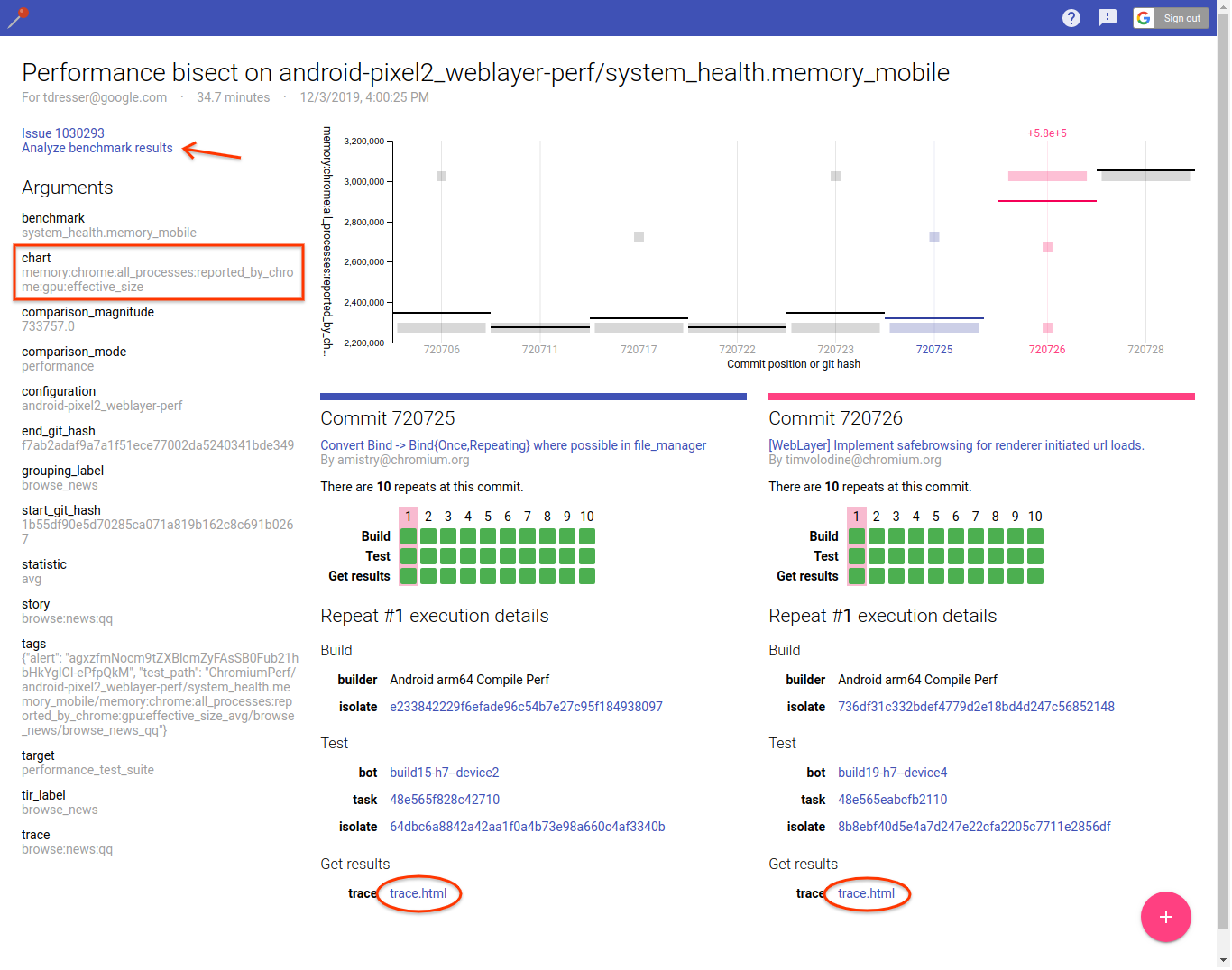 |
| |
| Note the "chart" argument identifies the memory metric that regressed. The |
| pinpoint results page also gives you easy access to traces before and after |
| your commit landed. It's useful to look at both and compare them to identify what |
| changed. The documentation on [memory-infra][memory-infra] explains how to dig |
| down into details and interpret memory measurements. Also note that pinpoint |
| runs each commit multiple times, so you can access more traces by clicking on |
| a different "repeat" of either commit. |
| |
| Sometimes it's also useful to follow the link to "Analyze benchmark results" |
| which will bring up the [Metrics Results UI][results-ui] to compare all |
| measurements (not just the one caught by the alert) before and after your |
| CL landed. Make sure to select the "before" commit as reference column, show |
| absolute changes (i.e. "Δavg") instead of relative, and sort by the column |
| with changes on the "after" commit to visualize them more easily. This can be |
| useful to find a more specific source of the regression, e.g. |
| `renderer_processes:reported_by_chrome:v8:heap:code_space:effective_size` |
| rather than just `all_processes:reported_by_chrome:effective_size`, and help |
| you pin down the source of the regression. |
| |
| To confirm whether a revert of your CL would fix the regression you can run |
| a [pinpoint try job](#How-to-run-a-pinpoint-try-job) with a patch containing |
| the revert. Finally, **do not close the bug** even if you suspect that your CL |
| may not be the cause of the regression; instead follow the more general |
| guidance on how to [address performance regressions][addressing-regressions]. |
| Bugs should only be closed if the regression has been fixed or justified. |
| |
| [results-ui]: https://chromium.googlesource.com/catapult.git/+/HEAD/docs/metrics-results-ui.md |
| [memory-infra]: /docs/memory-infra/README.md |
| [addressing-regressions]: /docs/speed/addressing_performance_regressions.md |
| |
| ## How to run the benchmarks |
| |
| Benchmarks may be run on a local platform/device or remotely on a pinpoint |
| try job. |
| |
| ### How to run a pinpoint try job |
| |
| Given a patch already uploaded to code review, try jobs provide a convenient |
| way to evaluate its memory implications on devices or platforms which |
| may not be immediately available to developers. |
| |
| 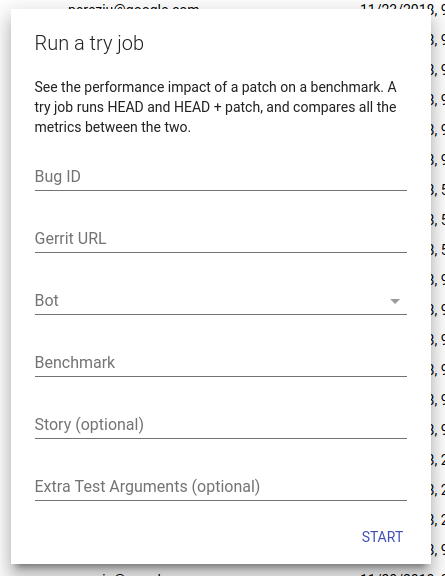 |
| |
| To start a try job go to the [pinpoint][] website, click on the `+` button to |
| create a new job, and fill in the required details: |
| |
| [pinpoint]: https://pinpoint-dot-chromeperf.appspot.com/ |
| |
| * **Bug ID** (optional): The id of a crbug.com issue where pinpoint can post |
| updates when the job finishes. |
| * **Gerrit URL**: URL to the patch you want to test. Note that your patch can |
| live in chromium or any of its sub-repositories! |
| * **Bot**: Select a suitable device/platform from the drop-down menu on which |
| to run your job. |
| * **Benchmark**: The name of the benchmark to run. If you are interested in |
| memory try `system_health.memory_mobile` or `system_health.memory_desktop` |
| as appropriate. |
| * **Story** (optional): A pattern (Python regular expression) passed to |
| Telemetry's `--story-filter` option to only run stories that match the |
| pattern. |
| * **Extra Test Arguments** (optional): Additional command line arguments for |
| Telemetry's `run_benchmark`. Of note, if you are interested in running a |
| small but representative sample of system health stories you can pass |
| `--story-tag-filter health_check`. |
| |
| If you have more specific needs, or need to automate the creation of jobs, you |
| can also consider using [pinpoint_cli][]. |
| |
| [pinpoint_cli]: https://cs.chromium.org/chromium/src/tools/perf/pinpoint_cli |
| |
| ### How to run locally |
| |
| After building, e.g. `ChromePublic.apk`, you can run a specific system health |
| story with the command: |
| |
| ``` |
| $SRC/tools/perf/run_benchmark run system_health.memory_mobile \ |
| --browser android-chromium --story-filter load:search:google |
| ``` |
| |
| This will run the story with a default of 3 repetitions and produce a |
| `results.html` file comparing results from this and any previous benchmark |
| runs. In addition, you'll also get individual [trace files][memory-infra] |
| for each story run by the benchmark. **Note:** by default only high level |
| metrics are shown, you may need to tick the "Show all" check box in order to |
| view some of the lower level memory metrics. |
| |
| 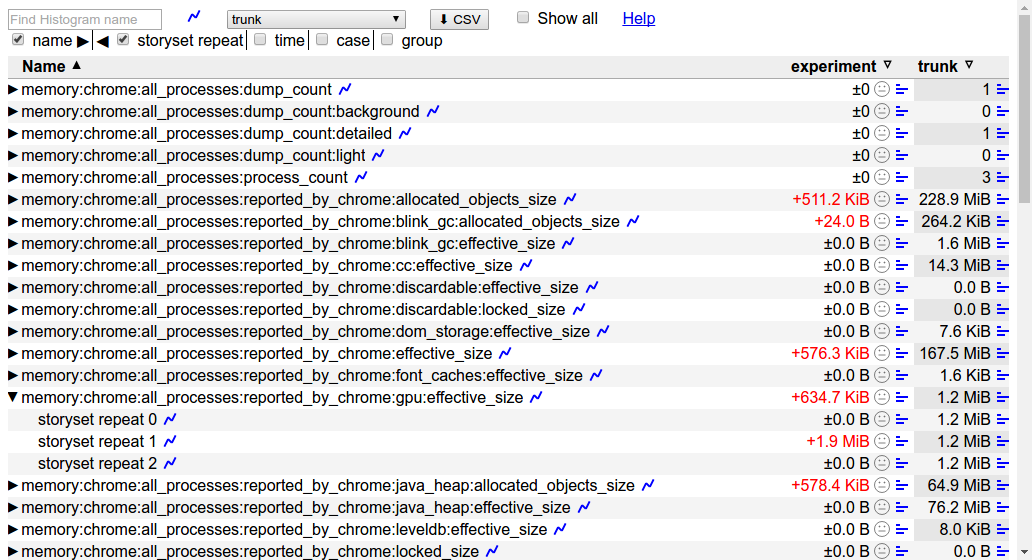 |
| |
| Other useful options for this command are: |
| |
| * `--pageset-repeat [n]` - override the default number of repetitions |
| * `--reset-results` - clear results from any previous benchmark runs in the |
| `results.html` file. |
| * `--results-label [label]` - give meaningful names to your benchmark runs, |
| this way it is easier to compare them. |
| |
| For WebView make sure to [replace the system WebView][webview_install] |
| on your device and use `--browser android-webview`. |
| |
| [memory-infra]: /docs/memory-infra/README.md |
| [webview_install]: https://www.chromium.org/developers/how-tos/build-instructions-android-webview |
| |
| ## Understanding memory metrics |
| |
| There is a large number of [memory-infra][] metrics, breaking down usage |
| attributed to different components and processes. |
| |
|  |
| |
| Most memory metrics have the form |
| `memory:{browser}:{processes}:{source}:{component}:{kind}` |
| where: |
| |
| * **browser:** One of `chrome` or `webview`. |
| * **processess:** One of `browser_process`, `renderer_processess`, |
| `gpu_process`, or `all_processess`. |
| * **source:** One of `reported_by_chrome` or `reported_by_os` |
| * **component:** May be a Chrome component, e.g. `skia` or `sqlite`; |
| details about a specific component, e.g. `v8:heap`; or a class of memory |
| as seen by the OS, e.g. `system_memory:native_heap` or `gpu_memory`. If |
| reported by chrome, the metrics are gathered by `MemoryDumpProvider`s, |
| probes placed in the specific components' codebase. For example, in |
| "memory:chrome:all_processes:reported_by_chrome:net:effective_size_avg," |
| the component is "net" which is Chrome's network stack and |
| "reported_by_chrome" means that this metric is gathered via probes in |
| the network stack. |
| * **kind:** The kind of memory being reported. For metrics reported by |
| Chrome this usually is `effective_size` (others are `locked_size` |
| and `allocated_objects_size`); for metrics by the OS this usually is |
| `proportional_resident_size` (others are `peak_resident_size` and |
| `private_dirty_size`). |
| |
| Read the [memory-infra documentation][memory-infra] for more details on them. |
| |
| [memory-infra]: /docs/memory-infra/README.md |